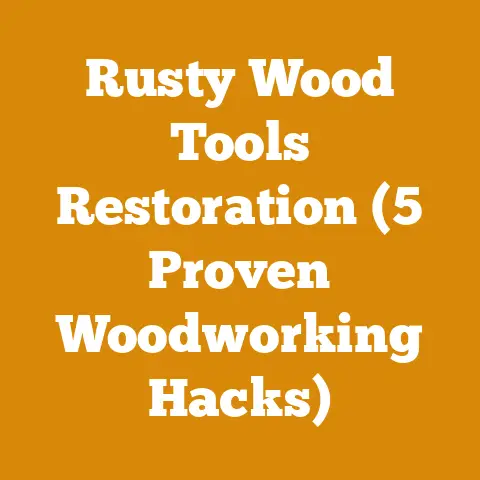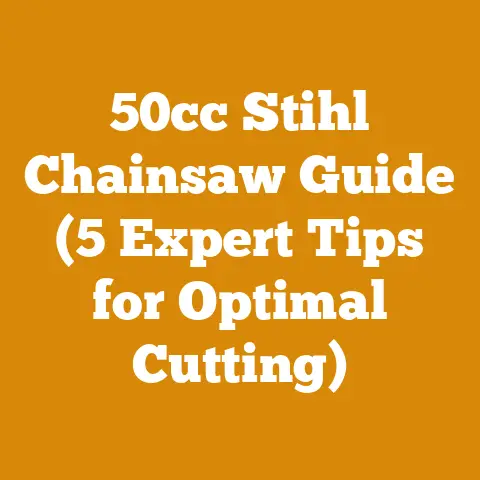Excavator Stump Removal Techniques (5 Pro Tips for Efficient Digging)
The world of forestry and land management is seeing a significant shift. While traditional logging practices remain important, there’s a growing emphasis on sustainable land clearing, responsible forestry, and efficient site preparation. This shift is driven by environmental concerns, stricter regulations, and a need for more productive land use. One aspect that’s becoming increasingly crucial is effective stump removal, and that’s where excavators come into play. They’re not just for digging; they’re powerhouses for extracting those stubborn remnants of felled trees.
Excavator Stump Removal Techniques: 5 Pro Tips for Efficient Digging
The goal here is to provide you with practical, actionable information to maximize efficiency, minimize environmental impact, and ensure safety. Let’s dive into the nitty-gritty.
1. Pre-Excavation Assessment and Preparation: Laying the Groundwork for Success
Before you even fire up that excavator, a thorough assessment is absolutely critical. Think of it as your pre-flight checklist. Rushing into the process is a recipe for disaster, potentially damaging your equipment, the surrounding environment, or even causing injury.
- Identify Stump Types and Sizes: Not all stumps are created equal. Pine stumps, for example, tend to be softer and decompose more quickly than oak stumps. The size and species will significantly impact your approach. As a rule of thumb, measure the stump diameter at ground level. Stumps less than 12 inches in diameter might be manageable with smaller excavators, while larger ones (12-36 inches) will require heavier machines. Anything above that? You’re in the realm of serious excavating power. I remember once underestimating the size of a cluster of oak stumps; ended up needing a much larger machine and a whole lot more time than I initially planned.
- Check for Underground Utilities: This is non-negotiable. Call your local utility companies and have them mark any underground lines. Striking a gas line or fiber optic cable can have devastating consequences. Most countries have a “call before you dig” service (e.g., 811 in the US). Use it. It’s free, and it’s a lifesaver.
- Clear the Area: Remove any debris around the stump, including rocks, branches, and overgrown vegetation. This provides better access for the excavator and reduces the risk of damaging the machine or creating hazards. I often find it useful to use a brush cutter or chainsaw to quickly clear the immediate vicinity.
- Soil Conditions: Consider the type of soil you’re dealing with. Sandy soil is easier to dig in than clay, but it can also lead to cave-ins. Waterlogged soil can make the stump heavier and more difficult to extract. Adjust your digging technique accordingly. If the soil is very wet, consider using a wider bucket to distribute the excavator’s weight and prevent it from sinking.
2. Excavator Bucket Selection and Attachment: Choosing the Right Tool for the Job
The type of bucket you use can make a huge difference in the efficiency and effectiveness of stump removal. It’s not a one-size-fits-all situation.
- Standard Excavator Bucket: This is your general-purpose bucket and can be used for smaller stumps and softer soils. However, it’s not ideal for larger stumps or tough conditions.
- Tooth Bucket: Buckets with teeth are designed for penetrating hard-packed soil and breaking up roots. They provide more aggressive digging power and are excellent for rocky or clay-rich soils. I find that a tooth bucket with replaceable teeth is a worthwhile investment, as the teeth will inevitably wear down over time.
- Frost Bucket: For frozen ground or extremely compacted soil, a frost bucket is your best bet. These buckets are heavily reinforced and have specialized teeth designed to shatter frozen material.
- Root Rake: This specialized attachment is designed specifically for removing roots and debris. It features long, curved tines that can easily separate roots from the soil. While not always necessary, a root rake can significantly speed up the cleanup process after stump removal.
- Quick Couplers: Investing in a quick coupler can save you a significant amount of time and effort. These devices allow you to quickly switch between different buckets and attachments without having to manually remove and reinstall pins.
Technical Specifications:
- Bucket Size: The appropriate bucket size will depend on the size of your excavator and the size of the stumps you’re removing. Generally, a bucket that is too small will be inefficient, while a bucket that is too large can overload the excavator. Consult your excavator’s operating manual for recommended bucket sizes.
- Tooth Type: For tooth buckets, consider the type of teeth. Chisel teeth are good for general digging, while tiger teeth are more aggressive and better for breaking up hard materials.
- Material: Look for buckets made from high-strength steel (e.g., AR400 or AR500). These materials offer excellent wear resistance and durability.
Personal Story: I once tried to remove a large oak stump with a standard bucket. After several hours of struggling, I finally switched to a tooth bucket. The difference was night and day. The tooth bucket sliced through the roots with ease, and I was able to remove the stump in a fraction of the time.
3. The Digging Process: Techniques for Efficient Stump Extraction
Now that you’ve assessed the situation and selected the right tools, it’s time to get digging. Here are some proven techniques to maximize efficiency and minimize the risk of damage.
- Start Wide: Begin by digging a wide circle around the stump, gradually working your way inward. This will expose the lateral roots and make them easier to cut or break. I typically aim for a diameter that is at least twice the diameter of the stump.
- Expose the Taproot: The taproot is the main root that grows vertically downward from the stump. It’s often the most difficult part to remove. Carefully dig around the taproot to expose it.
- Cut or Break the Roots: Once the roots are exposed, you can either cut them with the excavator bucket or break them by applying leverage. For smaller roots, the bucket teeth can often sever them cleanly. For larger roots, you may need to use the bucket edge to apply pressure and snap them. I sometimes use a hydraulic tree shear attachment for larger roots, which makes the process much faster and cleaner.
- Leverage the Stump: Once most of the roots are severed, use the excavator bucket to gently rock the stump back and forth. This will help to loosen any remaining roots and make it easier to lift the stump out of the ground. Be careful not to apply too much force, as this could damage the excavator or the stump.
- Lift and Remove: Once the stump is loose, carefully lift it out of the ground with the excavator bucket. Transport the stump to a designated disposal area.
Data Point: A study by the Forest Engineering Research Institute of Canada (FERIC) found that using a combination of digging and leveraging techniques can reduce stump removal time by up to 30% compared to simply digging around the stump.
Technical Tip: When digging around the stump, pay attention to the angle of the bucket. A slight angle can help to direct the force of the bucket towards the roots, making them easier to cut or break.
4. Environmental Considerations and Disposal: Minimizing Your Impact
Stump removal can have a significant impact on the environment. It’s important to take steps to minimize your impact and dispose of the stumps responsibly.
- Erosion Control: Stump removal can leave large holes in the ground, which can be susceptible to erosion. Backfill the holes with soil and compact it to prevent erosion. Consider planting native vegetation to further stabilize the soil.
- Topsoil Preservation: Topsoil is the most fertile layer of soil and is essential for plant growth. When removing stumps, try to preserve the topsoil by stockpiling it separately and then replacing it after the stump is removed.
- Disposal Options: There are several options for disposing of stumps, including:
- Landfill: This is the most common option, but it’s also the least environmentally friendly.
- Burning: Burning stumps can be an effective way to dispose of them, but it’s important to check local regulations and obtain any necessary permits. Burning can also release harmful pollutants into the air.
- Chipping: Chipping stumps into mulch is a more sustainable option. The mulch can be used for landscaping or as a soil amendment.
- Burial: Burying stumps on-site can be a viable option if you have enough space. However, the stumps will eventually decompose, which can cause the ground to sink.
- Biochar Production: A more innovative approach is to convert the stumps into biochar through pyrolysis. Biochar is a charcoal-like substance that can be used as a soil amendment, improving soil fertility and carbon sequestration.
Case Study: I worked on a project where we were clearing land for a new housing development. We used a combination of chipping and biochar production to dispose of the stumps. The wood chips were used as mulch in the landscaping, and the biochar was used to improve the soil quality in the gardens. This approach not only minimized our environmental impact but also created valuable products that benefited the community.
Data Point: A study by the International Biochar Initiative (IBI) found that biochar can significantly improve soil fertility, increase crop yields, and reduce greenhouse gas emissions.
Technical Requirement: When chipping stumps, ensure that the wood chips meet the required size specifications for the intended use. For example, mulch used in landscaping typically requires larger chips than mulch used as a soil amendment.
5. Safety Protocols and Best Practices: Protecting Yourself and Your Equipment
Safety should always be your top priority when operating heavy machinery. Stump removal can be a dangerous task, so it’s important to follow proper safety protocols and best practices.
- Personal Protective Equipment (PPE): Always wear appropriate PPE, including:
- Hard Hat: Protects your head from falling objects.
- Safety Glasses: Protects your eyes from flying debris.
- Hearing Protection: Protects your ears from the loud noise of the excavator.
- Gloves: Protects your hands from cuts and abrasions.
- Steel-Toed Boots: Protects your feet from injury.
- High-Visibility Clothing: Makes you more visible to other workers and equipment operators.
- Equipment Inspection: Before operating the excavator, thoroughly inspect it for any signs of damage or wear. Check the fluid levels, tires, tracks, and all moving parts.
- Operating Procedures: Follow the manufacturer’s operating procedures at all times. Never exceed the excavator’s load capacity.
- Communication: Use clear communication signals with other workers on the site. If you’re working with a spotter, establish a set of hand signals beforehand.
- Emergency Procedures: Know the location of the nearest first aid kit and fire extinguisher. Be prepared to respond to any emergencies that may arise.
- Training: Ensure that you are properly trained and certified to operate the excavator.
- Clear Communication: Keep all bystanders at a safe distance from the excavator. A general rule of thumb is to maintain a distance of at least twice the machine’s reach.
- Lockout/Tagout Procedures: Before performing any maintenance or repairs on the excavator, follow lockout/tagout procedures to prevent accidental start-up. This involves disconnecting the power source and attaching a tag to the control panel indicating that the machine is being worked on.
Technical Specification: According to OSHA regulations (e.g., 29 CFR 1926.602 for excavation equipment), all excavator operators must be trained and competent in the safe operation of the equipment. Training should include topics such as equipment inspection, operating procedures, hazard recognition, and emergency response.
Unique Insight: I’ve found that taking regular breaks during long stump removal projects can significantly improve safety and productivity. Fatigue can impair judgment and slow reaction times, increasing the risk of accidents. A short break every hour or two can help to keep you alert and focused.
Personal Story: I once witnessed a near-miss accident when a fellow operator failed to properly inspect his excavator before starting work. A hydraulic hose ruptured, spraying oil all over the machine. Fortunately, no one was injured, but it served as a stark reminder of the importance of following safety protocols.
By following these safety protocols and best practices, you can minimize the risk of accidents and ensure that your stump removal project is completed safely and efficiently. Remember, safety is not just a set of rules; it’s a mindset.
Conclusion
Excavator stump removal is a powerful and efficient method when done correctly. By following these five pro tips, you can maximize your productivity, minimize your environmental impact, and ensure your safety. Remember to always prioritize safety, plan your work carefully, and use the right tools for the job. With a little practice and patience, you’ll be removing stumps like a pro in no time.






